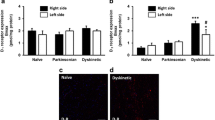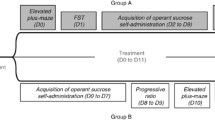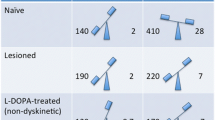Abstract
We had previously found that in animals with moderate nigro-striatal dopamine (DA) lesions (i.e. 45–65% residual neostriatal DA) the mixed D1/D2-agonist apomorphine induced ipsiversive rather than the usual contraversive turning found after more radical DA lesions. Since this result promised to provide a behavioral animal model for pre-clinical Parkinson's disease, we hoped to delineate the responsible receptor by challenging with selective D1- and D2-agonists. Thus, in the present study, the behavioral effects of the D1-agonist SKF38393 (5.0 mg/kg) and the D2-agonist LY171555 (0.5 mg/kg) were tested in drug-naive rats with unilateral 6-hydroxydopamine lesions of the nigro-striatal DA system. This analysis was performed dependent on the degree of the lesion, classified post-mortem with respect to the level of residual DA in the neostriatum: <20%, 20–45%, 45–65%, and >65% (as percentage of the intact hemisphere). The measures of turning, thigmotactic scanning and locomotion did not yield differences between animals treated with the D1-agonist and vehicle-treated rats. For example, animals with severe lesions (residual DA <20%) showed ipsiversive asymmetries in turning and scanning, which were similar after vehicle or the D1-agonist, both with respect to degree and time-course. However, the analysis of grooming behavior, which was performed in a subset of animals with moderate lesions yielded differences between vehicle and the D1-agonist, since the duration of grooming was increased after SKF38393. In contrast to the D1-agonist, behavioral effects after the D2-agonist LY17155 were evident in all behavioral measures. The general response to this agonist could be characterized by a rapid decrease of behavioral activity including turning, scanning, locomotion and grooming. Although we failed to find significant behavioral asymmetries with either agonist, a micro-analysis showed evidence for selective effects after the D2-agonist, since a contraversive asymmetry in turning (and scanning) became apparent between 45 and 60 min after injection in animals with severe lesions (residual DA of about 10% or less), and since there was a weak ipsiversive turning asymmetry in animals with residual DA levels of 45–65%. Such asymmetries were not observed after vehicle or the D1-agonist. The possible physiological mechanisms of these effects, i.e. DA receptor mechanisms and DA availability, are discussed in the context of results from previous experiments using lesioned or intact animals.
Similar content being viewed by others
References
Ariano MA (1988) Striatal D1 dopamine receptor distribution following chemical lesion of the nigrostriatal pathway. Brain Res 443:204–214
Arnt J, Hyttel J (1985) Differential involvement of dopamine D-1 and D-2 receptors in the circling behaviour induced by apomorphine, SK & F 38393, pergolide and LY 171555 in 6-hydroxydopamine-lesioned rats. Psychopharmacology 85:346–352
Braun AR, Chase TN (1986) Obligatory D-1/D-2 receptor interaction in the generation of dopamine agonist related behaviors. Eur J Pharmacol 131:301–306
Carey RJ (1986) Conditioned rotational behavior in rats with unilateral 6-hydroxydopamine lesions of the substantia nigra. Brain Res 365:379–382
Clarke D, White FJ (1987) D1 dopamine receptor — the search for a function: a critical evaluation of the D1/D2 dopamine receptor classification and its functional implications. Synapse 1:347–388
Creese I, Snyder SH (1979) Nigrostriatal lesions enhance striatal3H-apomorphine and3H-spiroperidol binding. Eur J Pharmacol 56:277–281
Eilam D, Szechtman H (1989) Biphasic effect of D-2 agonist quinpirole on locomotion and movements. Eur J Pharmacol 161:151–157
Eilam D, Talanbayan H, Canaran G, Szechtman H (1992) Dopaminergic control of locomotion, mouthing, snout contact, and grooming: opposing roles of D1 and D2 receptors. Psychopharmacology 106:447–454
Fletcher GH, Starr MS (1987) Topography of dopamine behaviours mediated by D1 and D2 receptors revealed by intrastriatal injection of SKF 38393, lisuride and apomorphine in rats with a unilateral 6-hydroxydopamine-induced lesion. Neuroscience 20:589–597
Fornaguera J, Schwarting RKW, Boix F, Huston JP (1993) Behavioral indices of moderate nigro-striatal 6-hydroxydopamine lesion: a preclinical Parkinson's model. Synapse 13:179–185
Fornaguera J, Carey RJ, Huston JP, Schwarting RKW (1994) Behavioral asymmetries and recovery in rats with different degrees of unilateral striatal dopamine depletion. Brain Res 664:178–188
Gower AJ, Marriott AS (1978) Pharmacological evidence for the subclassification of central dopamine receptors in the rat. Br J Pharmcol 77:185–194
Imperato A, Mulas A, Di Chiara G (1987) The D-1 antagonist SCH 23390 stimulates while the D-1 agonist SKF 38393 fails to affect dopamine release in the dorsal caudate of freely moving rats. Eur J Pharmacol 142:177–181
Imperato A, Tanda G, Frau R, Di Chiara G (1988) Pharmacological profile of dopamine receptor agonists as studied by brain dialysis in behaving rats. J Pharmacol Exp Ther 245:257–264
LaHoste GJ, Marshall JF (1992) Dopamine supersensitivity and D1/D2 synergism are unrelated to changes in striatal receptor density. Synapse 12:14–26
Ljungberg T, Ungerstedt U (1976) Sensory inattention produced by 6-hydroxydopamine-induced degeneration of ascending dopamine neurons in the brain. Exp Neurol 53:585–600
Longoni R, Spina L, Di Chiara G (1987) Permissive role of D-1 receptor stimulation for the expression of D-2 mediated behavioral responses: a quantitative phenomenological study in rats. Life Sci 41:2135–2145
Marshall JF, Richardson IS, Teitelbaum P (1974) Nigrostriatal bundle damage and the lateral hypothalamic syndrome. J Comp Physiol Psychol 88:808–830
Matsuda H, Hiyama Y, Terasawa K, Watanabe H, Matsumoto K (1992) Enhancement of rotational behavior induced by repeated administration of SKF38393 in rats with unilateral nigrostriatal 6-OHDA lesions. Pharmacol Biochem Behav 42:213–218
Mattingly BA, Rowlett JK, Lovell G (1993) Effects of daily SKF 38393, quinpirole, and SCH 23390 treatments on locomotor activity and subsequent sensitivity to apomorphine. Psychopharmacology 110:320–326
Meller E, Bordi F, Bohmaker K (1988) Enhancement by the D1 dopamine agonist SKF 38393 of specific components of stereotypy elicited by the D2 agonist LY 171555 and RU 24123. Life Sci 42:2561–2567
Miller R, Beninger RJ (1991) On the interpretation of asymmetries of posture and locomotion produced with dopamine agonists in animals with unilateral depletion of striatal dopamine. Prog Neurobiol 36:229–256
Mishra RK, Gardner EL, Katzman R, Makman MH (1974) Enhancement of dopamine-stimulated adenylate cyclase activity in rat caudate after lesions in substantia nigra: evidence for degeneration supersensitivity. Proc Natl Acad Sci USA 71:3883–3887
Molloy AG, Waddington JL (1984) Dopaminergic behaviour stereospecifically promoted by the D1 agonist R-SK & F 38393 and selectively blocked by the D1 antagonist SCH 23390. Psychopharmacology 82:409–410
Molloy AG, Waddington JL (1985) Sniffing, rearing and locomotor responses to the D-1 dopamine agonist R-SK&F 38393 and to apomorphine: differential interactions with the selective D-1 and D-2 antagonists SCH 23390 and metoclopramide. Eur J Pharmacol 108:305–308
Morelli M, Di Chiara G (1987) Agonist-induced homologous and heterologous sensitization to D-1- and D-2-dependent contraversive turning. Eur J Pharmacol 141:101–107
Morelli M, Fenu S, Di Chiara G (1987) Behavioural expression of D-1 receptor supersensitivity depends on previous stimulation of D-2 receptors. Life Sci 40:245–251
Morelli M, Fenu S, Garau L, Di Chiara G (1989) Time and dose dependence of the “priming” of the expression of dopamine receptor supersensitivity. Eur J Pharmacol 162:329–335
Morelli M, Fenu S, Cozzolino A, Pinna A, Carta A, Di Chiara G (1993) Blockade of muscarinic receptors potentiates D1 dependent turning behavior andc-fos expression in 6-hydroxydopamine-lesioned rats but does not influence D2 mediated responses. Neuroscience 53:673–678
O'Neill RD, Fillenz M (1985) Simultaneous monitoring of dopamine release in frontal cortex, nucleus accumbens and striatum: effects of drugs, circadian changes and correlations with motor activity. Neuroscience 16:49–55
Paulus MP, Geyer MA (1991) A scaling approach to find order parameters quantifying the effects of dopaminergic agents on unconditioned motor activity in rats. Prog Neuropsychopharmacol Biol Psychiatry 15:903–919
Paxinos G, Watson C (1986) The rat brain in stereotaxic coordinates. Academic Press, Sydney
Pucak ML, Grace AA (1991) Partial dopamine depletions result in an enhanced sensitivity of residual dopamine neurons to apomorphine. Synapse 9:144–155
Pycock CJ, Kilpatrick IC (1989) Motor asymmetries and drug effects. Behavioral analyses of receptor activation. In: Boulton AA, Baker GB, Bradshaw AJ (eds) Psychopharmacology, vol. 13, Neuromethods. Humana Press, Clifton, pp 1–93
Robertson GS, Robertson HA (1986) Synergistic effects of D1 and D2 dopamine agonists on turning behaviour in rats. Brain Res 384:387–390
Robinson TE, Castañeda E, Whishaw IQ (1990) Compensatory changes in striatal dopamine neurons following recovery from injury induced by 6-OHDA or methamphetamine: a review of evidence from microdialysis studies. Can J Psychol 44:253–275
Rouillard C, Bédard P, Falardeau P, Di Paolo T (1988) Repeated stimulation of D-1 receptors increases the circling response to bromocriptine in rats with a 6-OHDA lesion. Eur J Pharmacol 157:125–133
Schwarting RKW, Huston JP (1987a) Short-term effects of ether, equithesin and droperidol/fentanyl on catecholamine and indolamine metabolism in the brain of the rat. Neuropharmacology 26:457–461
Schwarting RKW, Huston JP (1987b) Dopamine and serotonin metabolism in brain sites ipsi- and contralateral to direction of conditioned turning in rats. J Neurochem 48:1473–1479
Schwarting RKW, Huston JP (1992) Behavioral concomitants of regional changes in the brain's biogenic amines after apomorphine and amphetamine. Pharmacol Biochem Behav 41:675–682
Schwarting RKW, Steiner H, Huston JP (1990) Effects of hemivibrissotomy in the rat: time-dependent asymmetries in turning and biogenic amines induced by apomorphine. Pharmacol Biochem Behav 35:989–994
Schwarting RKW, Bonatz AE, Carey RJ, Huston JP (1991a) Relationships between indices of behavioral asymmetries and neurochemical changes following mesencephalic 6-hydroxy-dopamine injections. Brain Res 554:46–55
Schwarting RKW, Steiner H, Huston JP (1991b) Asymmetries in thigmotactic scanning: evidence for a role of dopaminergic mechanisms. Psychopharmacology 103:19–27
Schwarting RKW, Goldenberg R, Steiner H, Fornaguera J, Huston JP (1993) A video image analyzing system for open-field behavior in the rat focusing on behavioral asymmetries. J Neurosci Methods 49:199–210
Seeman P (1987) Dopamine receptors and the dopamine hypothesis of schizophrenia. Synapse 1:133–152
Silverman PB (1991) Sensitization and conditioned rotation: apomorphine, quinpirole and SKF-38393 compared. Neuro Report 2:669–672
Starr MS (1988) D-1/D-2 behavioural interactions in the rat involving striatal dopamine D-1 receptors. Eur J Pharmacol 151:479–482
Starr BS, Starr MS (1986) Differential effects of dopamine D1 and D2 agonists and antagonists on velocity of movement, rearing and grooming in the mouse. Neuropharmacology 25:455–463
Staunton DA, Wolfe BB, Groves PM, Molinoff PB (1981) Dopamine receptor changes following destruction of the nigrostriatal pathway: lack of a relationship to rotational behavior. Brain Res 211:315–327
Steiner H, Bonatz AE, Huston JP, Schwarting RKW (1988) Lateralized wall-facing versus turning as measures of behavioral asymmetries and recovery of function after injection of 6-hydroxydopamine into the substantia nigra. Exp Neurol 99:556–566
Surmeier DJ, Reiner A, Levine MS, Ariano MA (1993) Are neostriatal dopamine receptors co-localized? Trends Neurosci 16:299–305
Ungerstedt U, Arbuthnott GW (1970) Quantitative recording of rotational behavior in rats after 6-hydroxydopamine lesions of the nigrostriatal dopamine system. Brain Res 24:485–493
Wachtel SR, Brooderson RJ, White FJ (1992) Parametric and pharmacological analyses of the enhanced grooming response elicited by the D1 dopamine receptor agonist SKF 38393 in the rat. Psychopharmacology 109:41–48
White FJ, Bednarz LM, Wachtel SR, Hjorth S, Brooderson RJ (1988) Is stimulation of both D1 and D2 receptors necessary for the expression of dopamine mediated behaviors? Pharmacol Biochem Behav 30:189–193
Zigmond MJ, Abercrombie ED, Berger TW, Grace AA, Stricker EM (1990) Compensations after lesions of central dopaminergic neurons: some clinical and basic implications. Trends Neurosci 13:290–296
Author information
Authors and Affiliations
Rights and permissions
About this article
Cite this article
Fornaguera, J., Huston, J.P., Schwarting, R.K.W. et al. Stimulation of D1- or D2-receptors in drug-naive rats with different degrees of unilateral nigro-striatal dopamine lesions. Psychopharmacology 119, 145–154 (1995). https://doi.org/10.1007/BF02246155
Received:
Revised:
Issue Date:
DOI: https://doi.org/10.1007/BF02246155




